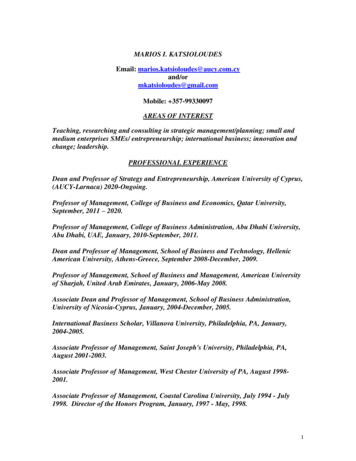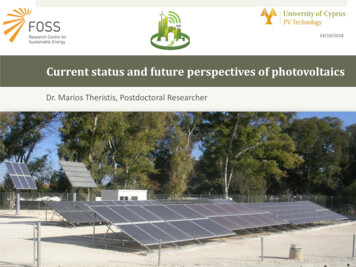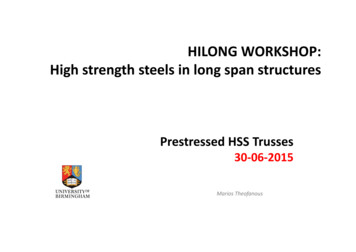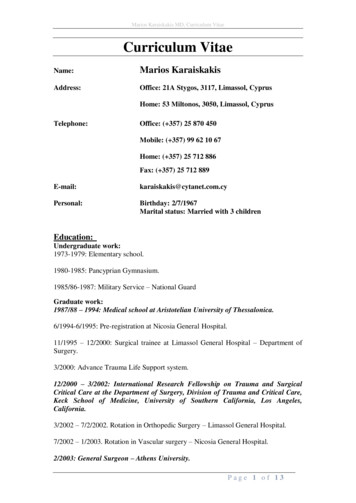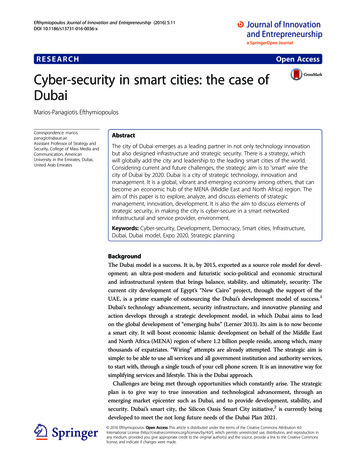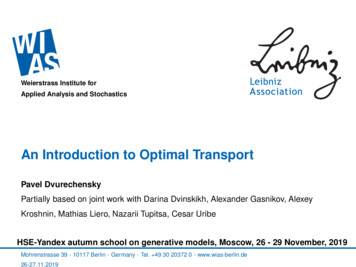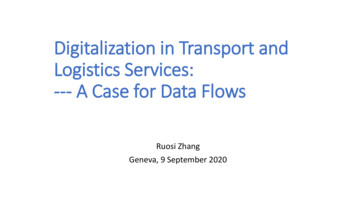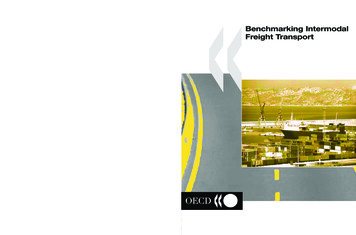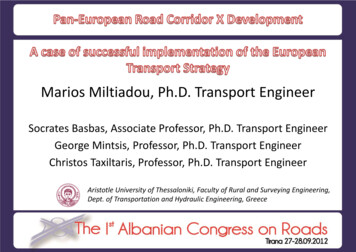
Transcription
Marios Miltiadou, Ph.D. Transport EngineerSocrates Basbas, Associate Professor, Ph.D. Transport EngineerGeorge Mintsis, Professor, Ph.D. Transport EngineerChristos Taxiltaris, Professor, Ph.D. Transport EngineerAristotle University of Thessaloniki, Faculty of Rural and Surveying Engineering,Dept. of Transportation and Hydraulic Engineering, Greece
1. Introduction2. Pan-European Transport Strategy in SEE:Planning and prioritising projects3. Pan-European Road Corridor Xdevelopment4. Conclusions – Discussion
Aim:– Presentation of a case of implementation of the European Transport Strategy inSEE, with the development of Pan-European Road Corridor X (PECX). Content:– First part: dedicated to the transport strategy for infrastructure developmentplanning in SEE, and especially to the principles for priority project definition andpromotion and the methodologies followed by the various planning exerciseselaborated.– Second part: dedicated to PECX development since the year 2000, with detailedreference to the initial plans for each section of the corridor and the respectiveactual progress made, accompanied with the results of the regional exercises forRoad PECX projects.– Final conclusions: formulated after the comparison of the actual progress with theinfrastructure investments criteria set and the results of the planning exercises,using also the experience from the involvement in the process of motorwayprojects financing on Road PECX.
Pan-European TransportConferences of Crete (1994) andHelsinki (1997) defined for the nonEU European territories: 10 Pan-European Corridors (PECs) 4 Areas (PETRAs) “Grid” of PECs in the SEE region: PECs IV (North-Southeast)V (West-East)VII (the Danube Inland Waterway)VIII (West-East)IX (North-East)X (Northwest-Southeast)
Transport Infrastructure NeedsAssessment (TINA) planning exercise:Based on the PECs, coordination of theinfrastructure investment plans of theacceding countries with those of the EUmember states, in view of the extensionof the TEN-T to the enlarged EU. Gap on the European mapNeed for further planning to cover thecountries of the WB participating in theStabilisation and Association Process.
SEE Strategic Network definition in2001, on the basis of the alreadyestablished PECs. Two strategic studies elaborated in2002 – 2003: the Transport InfrastructureRegional Study (TIRS) the Regional Balkans InfrastructureStudy (REBIS) Definition of the SEE Core TransportNetwork (nowadays called “SEEComprehensive Network”).
Proposal for revision of PECs: 5 Priority AxesSouth Eastern Axis: Mainly network of theexisting PECs Some PECs parts excluded(Branches B of PEC V and Dof PEC X, plus PECs IV andIX, which are now parts ofthe TEN-T) On the basis of MoU between EC and the WB countries (2004):– Development of the SEE Core Network– Negotiation for extension of the Acquis Communautaire in WB and establishmentof Treaty for a “Transport Community in SEE”
Current revision of TEN-T (2011Proposal – 1/2):– Transformation of the existingpatchwork of European roads,railways, airports and canals into aunified TEN-T.– Dual layer TEN-T: “Comprehensive”and “Core”.– “Core TEN-T”: to improve connectionsbetween different modes of transportand provide adequate connections toneighbouring countries, ensuringgeographical coverage
Investments and dimensioning of projects should correspond to the expectedin the next decade level of demand. Motorway construction for roads with AADT higher than 20.000 PCUs/day(UNECE). For road safety and networks’ consecutiveness completion of missing linksof existing motorway axes, even though the criterion of least daily trafficis not absolutely met. For railway projects: doubling of tracks and upgrading for speeds higherthan 160km/h presuppose demand higher than 100 trains/day. To achieve the optimum efficiency of transport infrastructure towards regionaldevelopment, special attention should be paid to: The improvement of the connection of isolated, insular or remote regionswith the Pan-European Transport Networks; Intermodality and sustainability; and The connection of ports and airports to the hinterland.
Strategic planning at Pan-European level: definition of themost urgent and with international impact projects. EC TEN-T guidelines (1996): the processing for the formulation ofproject proposals for financing focused in three terms: “projects ofcommon interest”, “bottlenecks” and “missing links.UNECE and ECMT (1993-1994): worked on the methodology fordefining common criteria for the identifying bottlenecks and missinglinks.TEN-Naxis (2007) and TEN-CONNECT (2009): worked also on thedefinition of the term “bottleneck”.HCM and the UIC guidelines were respectively the basic tools for roadand railway infrastructure capacity assessment.
Each of the strategic exercises elaborated for the transportinfrastructure development in SEE included methodologies forprioritising the projects with major importance for the region.Usually weighted MCA used (TIRS, REBIS, UNECE TEM/TER, SEETOconsultants).MCA methodologies: apparently valuable in the process of the SEEtransport network development.There are though, criteria which are more or less linked to the politicalcomponent of a project, i.e. the national priorities, but also the overallEU transport strategy (PECs).
Pan-European CorridorX is running throughthe South East Europeregion. It is the backbone of:- the SEE Core Network- the SEE Priority Axis forthe extension of themajor trans-Europeantransport axes to theneighbouring countriesand regions
ROAD Corridor X (Main Axis and branches): 2.300kmIn year 2000: 54% motorways (two or more lanes per direction) Since the year 2000, substantial investments have taken place,whilst large scale investments (with secured financing) are ongoing in Serbia and underway in F.Y.R.O.M.In year 2011: 78% motorways (89% of the Main Axis length). Completed motorway construction works in the period 20002011 corresponds to 24% of the Corridor’s total length.
Problematic sections along Road PECX: Characteristics, planned (inyear 2000), MCAs results and actual development by 2011
The recommendations of planning and prioritisation exercises have deviations from the actualinvestments made.Many sections had been suggested to be rehabilitated, based mainly on the demand criterion,but there are cases of promoting motorway construction on PECX against the low demandforecasts and socioeconomic indicators.Apart from the mature projects for motorway construction on the north-western parts of PECX inSlovenia and Croatia (Main Axis and Branch A), the only motorway projects prioritised by theregional studies were the construction of the Belgrade bypass and a Serbian part of Branch B. Inthe meantime, the construction of the Belgrade bypass restarted and between Novi Sad –Belgrade was finished. The attempt for concession of the rest of the Serbian Branch B wasunsuccessful and the motorway construction was completed recently as public work.The rest of the motorway projects realised or under construction are examples of projects thathave been promoted without the demand justifying the investments (e.g. V.Kopanica – Zupanja –Lipovac in Croatia, Tabanovce – Kumanovo in F.Y.R.O.M. with AADT of around 2.600PCUs/day inyear 2000 and 8.000PCUs/day in 2010). Finally one of the motorway projects recently put underconstruction is on Branch C, where from Nis to Dimitrovgrad a very difficult construction is ongoing to satisfy a demand that in 2010 fluctuated between 5.700 to 7.300 PCUs/day.
Cases of motorway projects promotion for implementation Transformation of the existing PECX parts from Leskovac to Presevo on the Main Axis inSerbia to a motorway.Transformation of the existing PECX parts between Demir Kapija and Gevgelija (near theGreek border) in F.Y.R.O.M. to a motorwayResults of Feasibility Studies and Cost Benefit Analyses (EIRR) of the projectsStudyFeasibility Study of construction in one stageFeasibility Study of staged construction (stage 2 after 25 years)Cost Benefit AnalysisSerbian project6,7%6,9%-F.Y.R.O.M. project6,5%7,5%4,5% Both projects are being realised, taking into account the regional geopolitics, thepotential of the increase of movements of persons or exchanges of goods andgenerally the expected high, but non quantifiable, benefits from the PECXcompletion for the socioeconomic and regional development.
The progress of Road PECX implementation during the last decade, in the framework ofthe Pan-European Transport Strategy, is remarkable.According to the recorded development and the projects underway, the Road PECX willbe developed a bit later than target year set for the PECs implementation (2015).Assessing the application of the European Transport Strategy guidelines in the case ofPECX motorway projects, it can be concluded that: The projects realised generally meet the principal set by the strategy to invest onthe improvement of the existing infrastructures. The MCA methodologies of the strategic exercises used criteria were more or lesslinked to the political component of projects, i.e. the national priorities but alsothe overall EU transport strategy (PECs). Projects on the PECs in the region had been prioritised, firstly because theybelonged to PECs, secondly because they were already prioritised by the nationalgovernments (as parts of the PECs and thus with higher financing potential) andfinally because the demand in the region is concentrated on these PECs. In otherwords, they met by default the criteria of functionality and coherence of thenetwork, the regional importance and the importance for international transport.
The actual traffic volumes along PECX, and even more on the SEE regional network, aremuch lower.Despite this, a lot of motorway projects along PECs, with socioeconomic, but mainlygeopolitical importance have been implemented.It can be said that the guidelines to build a regional infrastructure, and mainly toensure the consecutiveness of the network with the elimination of missing links,indeed had been taken into account when appraising motorway project proposals.This applies especially for projects at the southern and eastern parts of the Corridor,where demand is way below to support such decisions.Decision makers consider, not only the local impact of individual projects, but also theregional one, as well as the general condition (geopolitical, economic etc.) in each ofthe countries of the Corridor.
Thus, the success in the development of Road PECX was due a) to the promotion andimplementation of the project as a whole being priority of the EU Policies and b) due tothe increase of the maturity of many single projects along the Corridor.This presupposed the coordinated efforts of the countries, the stabilization of thesituation in the region and the general turn of the climate concerning the relations ofthe SEE countries with the international environment, institutions and organizations.Pan-European Corridor X would be in position soon, under the precondition ofelimination of border crossing obstacles that still exist, to serve efficiently the national,regional and international flows of goods and passengers from/to EU, the countries ofthe Corridor, Turkey and further to the East, given the fact that PECX provides the mainconnections of the Southeast Europe Network with the TEN-T Core Network and it willeventually become part of it after the accession of the WB countries in the EU.
Marios Miltiadou, Ph.D. Transport EngineerSocrates Basbas, Associate Professor, Ph.D. Transport EngineerGeorge Mintsis, Professor, Ph.D. Transport EngineerChristos Taxiltaris, Professor, Ph.D. Transport Engineerfor more information please contactDr. Marios D. MiltiadouTel: 30 2310 996126, Fax: 30 2310 996030Email: mmiltiadou@auth.gr
Aim: - Presentation of a case of implementation of the European Transport Strategy in SEE, with the development of Pan-European Road Corridor X (PECX). Content: - First part: dedicated to the transport strategy for infrastructure development planning in SEE, and especially to the principles for priority project definition and
